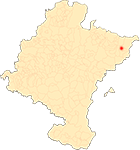Route through the Roncal altarpieces
By Ricardo Fernández Gracia
Main altarpiece of the parish church of Roncal
The account book of the parish of Roncal and a lawsuit brought by the mayor, juries and council of the town against the author of the altarpiece, Miguel de Garde, an architect who lived in Sangüesa, provide abundant information about the vicissitudes in the making of the altarpiece. The deed of adjustment was signed in January 1656 and the commitment fixed the deadline of six years to finish the work. As was usually the case, eleven years went by and it had not been completed submit, in response to which the people of Roncal brought the appropriate legal proceedings. Garde replied that he did not do so because he was not being paid what had been agreed years before. In 1666, the stonework pedestal was laid and finally, in 1677, it was appraised by two of the great masters of the time, José de Iturmendi and José de Huici e Ituren. Payments to Miguel de Garde were delayed, and some amounts were collected by the assignee of the master Juan Dionisio de la Hera and the latter's assignee, Vicente Salvo. The gilding of the altarpiece was carried out little by little. The polychromy of the tabernacle was done by position Ildefonso Mendoza around 1716; in 1719, Joaquín Elizondo stewed the sculptures and reliefs and, in the mid-1920s, it was completed with the gilding of the entire architecture of the altarpiece by the masters Matías Moler and the aforementioned Ildefonso de Mendoza.
The altarpiece on its design is a little late, still depending on late Romanesque models. It consists of a bench with reliefs between double foliage corbels, two sections with three aisles divided by paired columns with the lower third of the shaft in zigzag and the rest ribbed, and the triple attic between machones. The fleshy, proto-baroque decoration is limited to the niches and the entablatures.
The iconography is made up of isolated figures of saints, with the exception of the reliefs on the bench that depict the scenes of the Prayer in the Garden and the Way to Calvary. In the first section, Saint Stephen is flanked by the other two deacons, Saint Vincent and Saint Lawrence; in the second, Saint John the Baptist, Saint Sebastian and a bishop who could perhaps be identified with Saint Fermin; and in the attic, Calvary with Saint Bartholomew and Saint James on either side.
Parish archives of Garde, Vidángoz, Isaba, Uztárroz and Roncal.
file Diocesan of Pamplona. Processes
file General of Navarre. Roncal Notary's Office and Processes
ARDANAZ IÑARGA, N., La catedral de Pamplona en el siglo de las Luces. Arte, ceremonial y cultura, Pamplona, doctoral dissertation sustained at the University of Navarre, 2011. Vid. http://hdl.handle.net/10171/20480
BOLOQUI LARRAYA, B., Escultura zaragozana en la época de los Ramírez 1710-1780, Madrid, Ministerio de Cultura, 1983.
CHOCARRO HUESA, M., "El obispo Juan Rena, mediador y mecenas artístico de la catedral de Pamplona", Príncipe de Viana, 256 (2012), Issue dedicated to: programs of study sobre el Patrimonio Cultural y las artes en Navarra en torno a tres hitos 1212-1512-1812, (coordinated by Ricardo Fernández Gracia), pp. 587-601.
CLAVERÍA ARANGUA, J., Iconografía y santuarios de la Virgen en Navarra, vol. I, Madrid, Gráfica management assistant, 1942.
ECHEVERRÍA GOÑI, P., Polychromy of the Renaissance in Navarre, Pamplona, Government of Navarre, 1990.
GARCÍA GAÍNZA, M. C., Romanesque sculpture in Navarre. Disciples and followers of Juan de Anchieta, Pamplona, 1969.
GARCÍA GAÍNZA, M. C. et alt., Catalog Monumental de Navarra, IV* y IV**. Merindad de Sangüesa, Pamplona, Government of Navarra - Archbishopric of Pamplona - University of Navarra, 1989 and 1992.
FERNÁNDEZ GRACIA, R., El retablo barroco en Navarra, Pamplona, Government of Navarre, 2003.
FERNÁNDEZ GRACIA, R., "Los géneros escultóricos", El arte del Barroco en Navarra, (coord. R. Fernández Gracia), Pamplona, Gobierno de Navarra, 2014, pp. 175-271.
GÁRRIZ, J., La villa de Garde en el Valle del Roncal. essay de una monografía parroquial, Pamplona, Casa publishing house de G. Huarte, 1923.
HUALDE, F., "De cuando los Ezquer cruzaron el charco", Diario de Noticias de Navarra, 18 August 2008. http://patrimonionavarra2.blogspot.com.es/2010/09/18-de-agosto-de-2008.html
MORALES SOLCHAGA, E., "El gremio de San José y Santo Tomás de Pamplona hasta el siglo XVII", Príncipe de Viana, no. 239 (2006), pp. 791-860.
URANGA, J. E., Retablos navarros del Renacimiento, Pamplona, Institución Príncipe de Viana, 1947.












